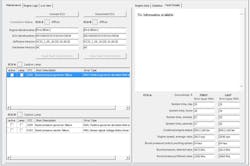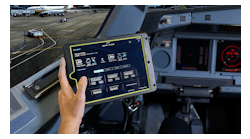Data acquisition technology is slowly making its way into the general aviation market and with that, come some differences in the way owners and aviation technicians must look at aircraft maintenance and troubleshooting. Engine and aircraft data collection has long been a part of the airline industry, but is now becoming more common place in general aviation. This is happening right under the nose of many new aircraft owners. As owners upgrade to multi-probe EGT/CHT systems, many new units have data collection built right into the software that drives the unit. While the amount of data collected pales in comparison to commercial aircraft, it is still useful to the general aviation owner/operator.
Typical EGT/CHT systems only record parameters every few seconds where as many commercial aircraft systems record every second, thus providing a much larger data stream to analyze. Many new glass panel cockpits record certain flight/engine parameters, which then can be easily downloaded at the end of the flight. This gives the owner a chance to review the flight and self-assess their performance directly following the flight. Most general aviation data collection is on the “choppy” side though, meaning the recording is only every four to six seconds. Full Authority Digital Engine Control (FADEC) systems on the other hand are more like systems found on airliners. It is common with a FADEC controlled engine to collect 30 or more engine parameters every second and easily store 100 or more hours of data, before needing to be downloaded or overwritten.
Data acquisition is a blessing in disguise for the modern day aircraft technician. The old days of the pilot telling the technician what happened in the flight and then having to troubleshoot the problem based solely off that information are slowly disappearing. Technicians have been faced for years with Service Bulletin compliance in regards to discrepancies like engine overboosts and overspeeds, based only on the pilot/owners report of the problem. Pilots often have heavy workloads in certain segments of their flights, like takeoff and landing and may not see the highest manifold pressure or RPM at the time of the occurrence. Data acquisition eliminates any ambiguity regarding what actually happened within the flight and now technicians can simply download the data and confirm the level of engine overboost or overspeed. No more wondering or “Gut” feeling of it may have been worse than reported and questioning whether you should have done more.
The big driving force of data acquisition is operational cost reduction. Fuel is the biggest area where improvements in efficiency can result in significant cost savings. In the world of general aviation, running an engine at its optimal mixture ratio for that particular flight might not save as much as a modern airliner running more efficiently, but it is a cost savings none the less. Other factors driving data are product improvements and redesign, manufactures can look at the data and see if any improvement are needed. This can also spill over into the supply chain, aiding in reduced parts inventory or even just-in-time inventory, thus reducing overhead. Lastly, data can be used to add or improve training. If an engine regularly encounters an overspeed on takeoff, then it may be a simple training issue, requiring a longer engine warm up period or a procedural adjustment.
The most important part to engine/aircraft data acquisition is the advancements in the field of Artificial Intelligence (AI) and Machine learning. While general aviation is a few years away from this beginning to be commonplace, predictive maintenance software is improving from year to year. Computers crunching data and discrepancies form aircraft engines and airframes is a step in the direction of predicting the next maintenance action item ahead of a component failure. Vibration levels, temperatures, pressures and speeds are only a few of the data streams that can aid in predicting component life and are what is being used to do what we call machine learning. Computers are analyzing these types of data to determine potential future component failures.
So how does the typical General Aviation owner/operator take advantage of the Data?
As we spoke of previously, airlines have long been analyzing data and have powerful software packages and personal dedicated to just this process of analyzing data. In the general aviation world, we also have software that runs the particular system; this software is utilized for viewing the data stream and downloading raw data for export. These types of software often only help us view the data, we still have to analyze it and look for trends. The best practice is to get familiar with this software and practice downloading and viewing files, which is the first step. Secondly, you should sit down with your technician and learn a little about Exhaust Gas Temperature, Cylinder Head Temperature, Fuel Flow and Power settings for your particular engine. You really only need a few engine parameters to be able to start trend analyzing and troubleshooting an engine. Some of the basics are if your EGT’s are running high, then you may be running to lean (procedural problem) or you could have low fuel pump pressure. Leaner means hotter and could cause unnecessary wear on the engine and even potentially burn a valve. Another example is if a single cylinder EGT is running lean, it could be an indication of a dirty fuel injector nozzle. EGT and CHT monitoring may also reveal such problems as fouled sparkplugs or even incorrect magneto ignition timing. Yet another is Manifold pressure, which could reveal induction leak problems and turbocharger problems if your engine is so equipped.
In order to analyze these situations you may have to look at the “Trend” and this could require you to export the data and load into Excel or an equivalent software so that you can plot out the trend. If you are not the tech savvy operator owner, you can go the route of having a professional do all this for you. For around $150-200 a year for a single engine aircraft there are services that will analyze this data for you and provide a rather detailed report of what is going on with your engine/aircraft and even often compare it to other like type engines/aircrafts. Just remember, if you go this route, you still have to be able to download and export the data to the service.
Data collection and AI are a pair meant to work together and surly will make their way more and more into general aviation over the years. Can one day we see the end of Aircraft-On-Ground (AOG) situations? Could we see the end of aircraft maintenance delays? These are the questions we hope to find answers too, but only time will tell. The one certain thing is that this is coming and will become more and more common, even in general aviation.





